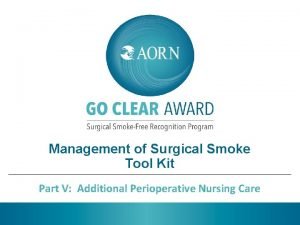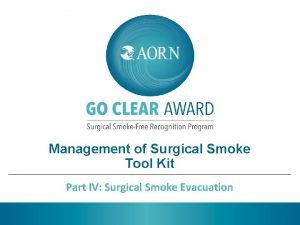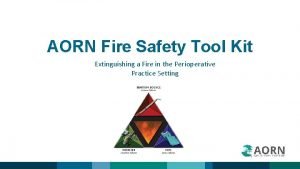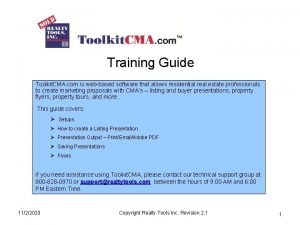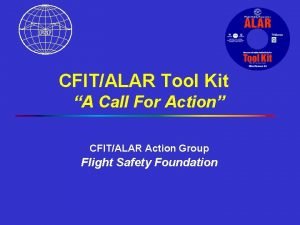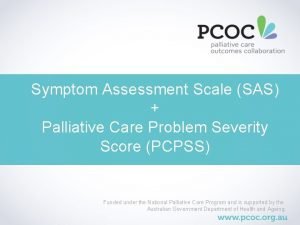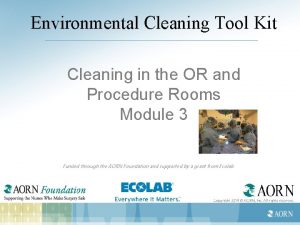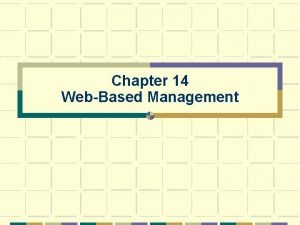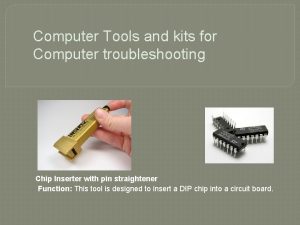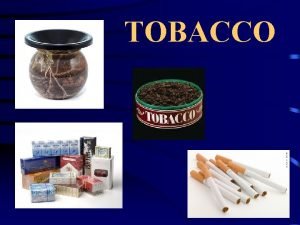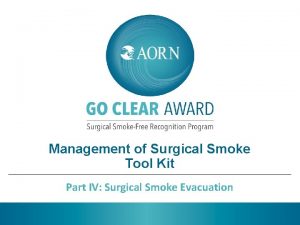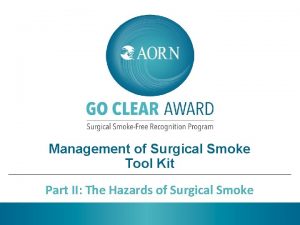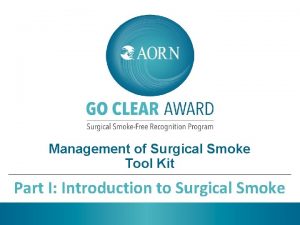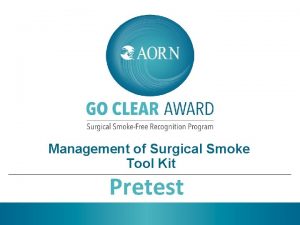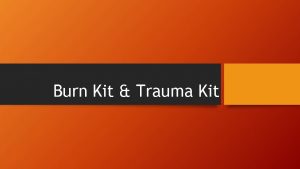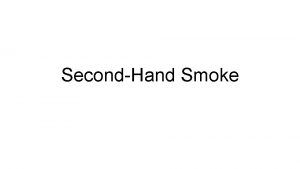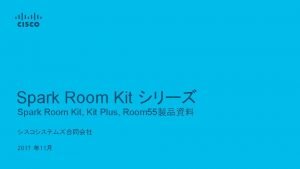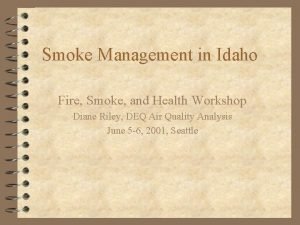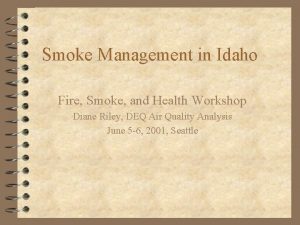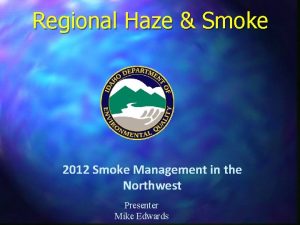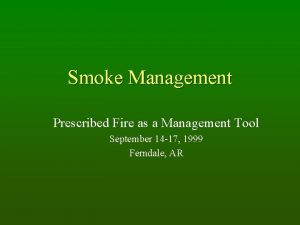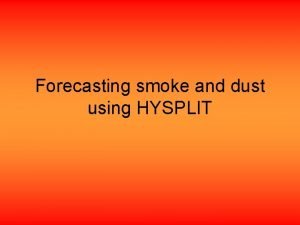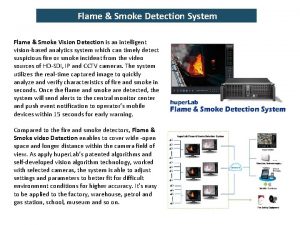Management of Surgical Smoke Tool Kit Part IV




















- Slides: 20

Management of Surgical Smoke Tool Kit Part IV: Surgical Smoke Evacuation

Instructions to the Learner This tool kit contains five slide decks related to the management of surgical smoke in the perioperative setting. It is recommended to review the slide decks in order. This is Part IV. • Part I: Introduction to Surgical Smoke • Part II: Hazards of Surgical Smoke • Part III: An Overview of Health Care Regulations, Standards, and Guidelines Related to Surgical Smoke • Part IV: Smoke Evacuation in the Perioperative Setting • Part V: Additional Perioperative Nursing Care

Part IV Smoke Evacuation in the Perioperative Setting

Evacuate Surgical Smoke • Smoke evacuator systems • In-line filters • MIS smoke evacuation systems

Evaluating Smoke Evacuators • Many products • Evaluate the features and benefits

Evaluating Smoke Evacuation Systems • Type of filters (eg, ULPA, carbon) • Type of filter monitoring system • Does the system have • variable flow rates to accommodate different amounts of smoke? • automatic remote activation? • • Noise level Is the system compatible with existing products? How effective and efficient is the system? Cost

Critical Features of Smoke Evacuators Efficiency • Filtering capability • Suction power

Smoke Capture • • Motor rating Tubing size Site proximity Amount of smoke generated

Triple Filter System • Pre-filter (captures large particles) • ULPA filter (captures small particles) • Charcoal filter (captures toxic gases and odors)

Wall Suction: Use an In-Line Filter • Use an in-line filter: • Use and change as recommended by the manufacturer’s instructions • Use standard precautions when changing and disposing of in-line filters

In-Line Filters with Wall Suction To wall suction > From the patient > Example of a filter

Wall Suction • When there is no in-line filter: • Damage to health care facility air exchange system

Evacuating Surgical Smoke During Minimally Invasive Procedures • Use an individual smoke evacuation unit • with a 0. 1 micron filter • Evacuate and filter surgical smoke • during the procedure • at the end of the procedure when the pneumoperitoneum is released .

Disposing of and Changing Smoke Evacuation Filters • It’s an occupational hazard. • Wear personal protective equipment. • Dispose of used smoke evacuation filters per the manufacturer’s instructions and your facility’s procedures for disposing of biohazardous waste.

Smoke Evacuation Program • Increase awareness of the hazards of surgical smoke • Promote and implement safe practices • Interdisciplinary team • Include perioperative RNs, anesthesia professionals, surgeons, scrub persons, and personnel from administration, infection prevention, employee health, safety, and risk management

Administration: Director Infection Prevention Safety Risk Management Perioperative RNs, Scrub Personnel, Sterile Processing, Environmental Services Promote Evidence– Based Practices Business and Finance: Contracts Capital Cost Analysis Surgeons and other Physicians

Implementing Smoke Evacuation Practices • Provide data and evidence to support best practices • Scientific research data - Financial analysis - AORN guidelines for perioperative practice • Work collaboratively • Administrative Safety Committee • Infection Prevention • Risk Management

Barriers to Compliance for Smoke Evacuation Practices • Equipment not available • Physician preference • Equipment is noisy • Complacent staff -- Ball, 2010 • Surgeons’ resistance or refusal • Noise • Cost • Ergonomic difficulty of equipment • Bulkiness • Excessive noise --Edwards & Reiman, 2012 • Distraction --Watson, 2010

Summary • There a variety of smoke evacuators available. • Select a smoke evacuator that meets the needs of the patient and the health care facility. • Wear PPE when handling and disposing of smoke evacuation filters. • Convening an interdisciplinary team is recommended to help develop and maintain a successful Smoke Evacuation Program at your health care facility.

End of Part IV Please continue to the next slide deck: Part V • Part I: Introduction to Surgical Smoke • Part II: Hazards of Surgical Smoke • Part III: An Overview of Health Care Regulations, Standards, and Guidelines Related to Surgical Smoke • Part IV: Smoke Evacuation in the Perioperative Setting • Part V: Additional Perioperative Nursing Care
 Managing surgical smoke
Managing surgical smoke Gordochom precio
Gordochom precio Surgical plume evacuator tool
Surgical plume evacuator tool Strikethrough sterile field
Strikethrough sterile field Sanctuary 7 commitments
Sanctuary 7 commitments Aorn fire risk assessment
Aorn fire risk assessment Corporate governance tool kit
Corporate governance tool kit Aorn fire safety
Aorn fire safety Workforce tool set
Workforce tool set Toolkitcma login
Toolkitcma login Cfit alar
Cfit alar Tool kit learning walk
Tool kit learning walk Pcoc assessment tool kit
Pcoc assessment tool kit Ecolab housekeeping tool kit
Ecolab housekeeping tool kit Java dynamic management kit
Java dynamic management kit Potter's tool is data cleaning tool
Potter's tool is data cleaning tool Part retriever tool function
Part retriever tool function Mainstream smoke
Mainstream smoke Dave dodson art of reading smoke
Dave dodson art of reading smoke Digital smoke signals
Digital smoke signals Smoke eater definition
Smoke eater definition
